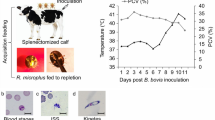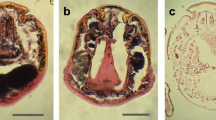Abstract
The relative DNA levels of different developmental stages ofTheileria annulata andT. parva in the cow and the tick were measured by the cytophotometric DNA technique using the fluorochrome Hoechst 33258 as a staining dye. The results revealed that sporozoites, merozoites, gamonts, and gametes were haploid, whereas multinucleated intralymphocytic schizonts were polyploid. No difference was observed betweenT. parva andT. annulata in these stages. For bothTheileria species, the DNA measurements revealed that fusion of gametes occurred in the gut of the final host, thus providing evidence of sexual reproduction. However, differences were observed between the two parasites in the tick. WhereasT. parva zygotes underwent a two-step meiotic division, a comparable reduction division could not be unequivocally detected inT. annulata. Differences could also be detected in the further development of kinetes, indicating thatTheileria species are not characterized by only one life cycle, which is specific for this genus.
Similar content being viewed by others
References
Allsopp MTEP, Cavalier-Smith T, De Waal DT, Allsopp BA (1994) Phylogeny and evolution of the piroplasms. Parasitology 108:147–152
Brocklesby DW, Barnett SF, Scott GR (1961) Morbidity and mortality rates of East Coast fever (Theileria parva infection) and their application to drug screening procedures. Br Vet J 17:529–531
Ellis J, Hefford C, Baverstock PR, Dalrymple BP, Johnson AM (1992) Ribosomal DNA sequence comparison ofBabesia andTheileria. Mol Biochem Parasitol 54:87–96
Kakoma I, Mehlhorn H (1994)Babesia of domestic animals. In: Kreier JP (ed) Parasitic protozoa, vol 7. Academic Press, San Diego, pp 141–216
Kappmeyer LS, Perryman LE, Knowles DP (1993)Babesia equi encodes a surface protein with homology toTheileria species. Mol Biochem Parasitol 62:121–124
Kleine FK (1906) Kultivierungsversuch der Hundepiroplasmen. Z Hyg Infektionskr 54:11–16
Koch R (1906) Beiträge zur Entwicklungsgeschichte der Piroplasmen. Z Hyg Infektionskr 54:1–9
Mackenstedt U, Gauer M, Mehlhorn H, Schein E, Hauschild S (1990) Sexual cycle ofBabesia divergens confirmed by DNA measurements. Parasitol Res 76:199–206
Mackenstedt U, Luton K, Baverstock PR, Johnson AM (1994) Phylogenetic relationships ofBabesia divergens as determined from comparison of small subunit ribosomal RNA gene sequences. Mol Biochem Parasitol 68:161–165
Mackenstedt U, Gauer M, Fuchs P, Zapf F, Schein E, Mehlhorn H (1995) DNA measurements reveal differences in the life cycles ofBabesia bigemina andB. canis, two typical members of the genusBabesia. Parasitol Res (in press)
Mehlhorn H, Piekarski G (1989) Grundriß der Parasitenkunde, 3rd edn. G. Fischer, Stuttgart New York, p 102
Mehlhorn H, Schein E (1976) Elektronenmikroskopische Untersuchungen an Entwicklungsstadien vonTheileria parva (Theiler 1904) im Darm der ÜberträgerzeckeHyalomma anatolicum excavatum (Koch, 1844) Trop Med Parasitol 27:182–191
Mehlhorn H, Schein E (1984) The piroplasms: life cycle and sexual stages. Adv Parasitol 23:38–103
Mehlhorn H, Weber G, Schein E, Büscher G (1975) Elektronenmikroskopische Untersuchungen an Entwicklungsstadien vonTheileria annulata (Dschunkowski, Luhs, 1904) im Darm und in der Hämolymphe vonHyalomma anatolicum excavatum (Koch, 1844). Z Parasitenkd 48:137–150
Mehlhorn H, Schein E, Ahmed JS (1994)Theileria. In: Kreier JP, Baker JR (eds) Parasitic protozoa, vol 7. Academic Press, San Diego, pp 217–304
Purnell RE, Joyner LP (1968) The development ofTheileria parva in the salivary glands of the tick,Rhipicephalus appendiculatus. Parasitology 58:725–732
Schein E, Friedhoff KT (1978) Lichtmikroskopische Untersuchungen über die Entwicklung vonTheileria annulata (Dschunkowski und Luhs, 1904) inHyalomma anatolicum excavatum (Koch, 1844). II. Die Entwicklung in Hämolymphe und Speicheldrüsen. Z Parasitenkd 56:287–303
Schein E, Büscher G, Friedhoff KT (1975) Lichtmikroskopische Untersuchungen über die Entwicklung vonTheileria annulata (Dschunkowski and Luhs, 1904) inHyalomma anatolicum excavatum (Koch, 1844). I. Die Entwicklung im Darm vollgesogener Nymphen. Z Parasitenkd 48:123–136
Young AS, Grootenhuis JG, Leitch BL, Schein E (1980) The development ofTheileria = Cytauxzoon taurotragi (Martin and Brocklesby, 1960) from eland in its tick vectorRhipicephalus appendiculatus. Parasitology 81:129–144
Zapf F, Schein E (1994a) The development ofBabesia (Theileria) equi (Laveran, 1901) in the gut and the haemolymph of the vector ticks,Hyalomma species. Parasitol Res 80:297–302
Zapf F, Schein E (1994b) New findings in the development ofBabesia (Theileria) equi (Laveran, 1901) in the salivary glands of the vector ticks,Hyalomma species. Parasitol Res 80:543–548
Author information
Authors and Affiliations
Additional information
Supported by Deutsche Forschungsgemeinschaft (DFG)
deceased
Rights and permissions
About this article
Cite this article
Gauer, M., Mackenstedt, U., Mehlhorn, H. et al. DNA measurements and ploidy determination of developmental stages in the life cycles ofTheileria annulata andT. parva . Parasitol Res 81, 565–574 (1995). https://doi.org/10.1007/BF00932023
Received:
Accepted:
Issue Date:
DOI: https://doi.org/10.1007/BF00932023




